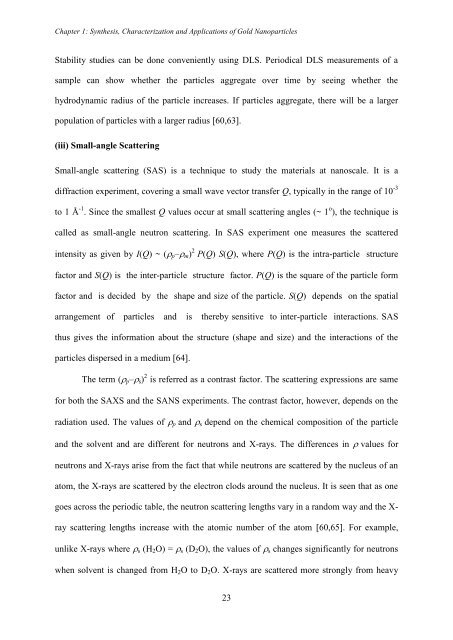PHYS01200704032 Debes Ray - Homi Bhabha National Institute
PHYS01200704032 Debes Ray - Homi Bhabha National Institute
PHYS01200704032 Debes Ray - Homi Bhabha National Institute
Create successful ePaper yourself
Turn your PDF publications into a flip-book with our unique Google optimized e-Paper software.
Chapter 1: Synthesis, Characterization and Applications of Gold Nanoparticles<br />
Stability studies can be done conveniently using DLS. Periodical DLS measurements of a<br />
sample can show whether the particles aggregate over time by seeing whether the<br />
hydrodynamic radius of the particle increases. If particles aggregate, there will be a larger<br />
population of particles with a larger radius [60,63].<br />
(iii) Small-angle Scattering<br />
Small-angle scattering (SAS) is a technique to study the materials at nanoscale. It is a<br />
diffraction experiment, covering a small wave vector transfer Q, typically in the range of 10 -3<br />
to 1 Å -1 . Since the smallest Q values occur at small scattering angles (~ 1 o ), the technique is<br />
called as small-angle neutron scattering. In SAS experiment one measures the scattered<br />
intensity as given by I(Q) ~ ( p – m ) 2 P(Q) S(Q), where P(Q) is the intra-particle structure<br />
factor and S(Q) is the inter-particle structure factor. P(Q) is the square of the particle form<br />
factor and is decided by the shape and size of the particle. S(Q) depends on the spatial<br />
arrangement of particles and is thereby sensitive to inter-particle interactions. SAS<br />
thus gives the information about the structure (shape and size) and the interactions of the<br />
particles dispersed in a medium [64].<br />
The term ( p – s ) 2 is referred as a contrast factor. The scattering expressions are same<br />
for both the SAXS and the SANS experiments. The contrast factor, however, depends on the<br />
radiation used. The values of p and s depend on the chemical composition of the particle<br />
and the solvent and are different for neutrons and X-rays. The differences in values for<br />
neutrons and X-rays arise from the fact that while neutrons are scattered by the nucleus of an<br />
atom, the X-rays are scattered by the electron clods around the nucleus. It is seen that as one<br />
goes across the periodic table, the neutron scattering lengths vary in a random way and the X-<br />
ray scattering lengths increase with the atomic number of the atom [60,65]. For example,<br />
unlike X-rays where s (H 2 O) = s (D 2 O), the values of s changes significantly for neutrons<br />
when solvent is changed from H 2 O to D 2 O. X-rays are scattered more strongly from heavy<br />
23

















